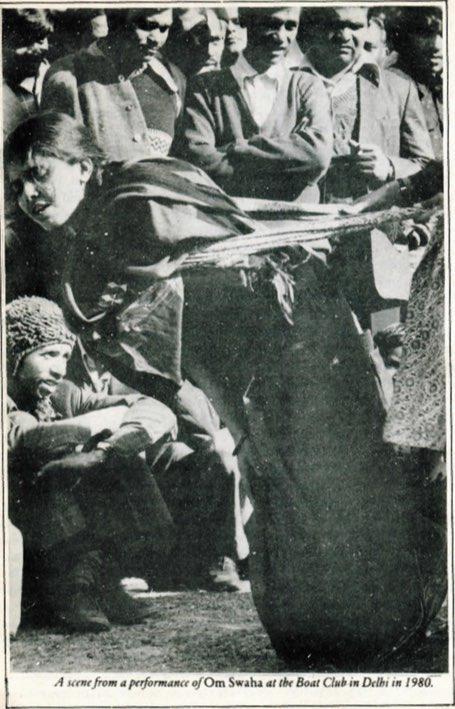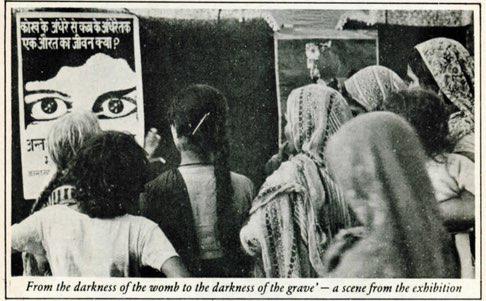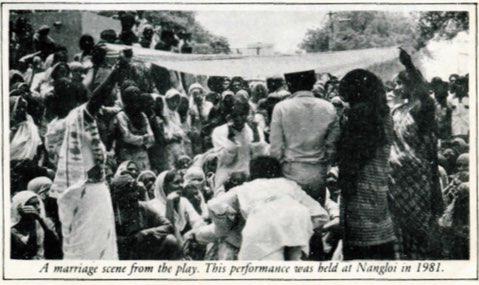Two Attempts by Women's Groups
Amrita Chhachhi
How far has the women's movement realised the inadequacy of the official media and tried to develop alternative forms to reach out to people? If we take as alternative forms those that are non-institutional then the women's movement in India reveals a tremendous creativity in the use of street theatre, exhibitions, posters and new kinds of leaflets in all its campaigns. In fact, the use of the visual image, especially in the placards carried for demonstrations, posters stuck on city walls, etc., has made this movement significantly different from other political campaigns. Alternative to the glossy women's magazines, are Manushi, a feminist journal which has become a forum for women to speak out, to share their personal experiences as women; posters analysing and challenging the image of women projected by the advertising media and circulated at conferences; posters which draw on traditional sources of female power and struggle (Shakti), linking them to the contemporary movement; a women's calendar with songs and poems speaking of menstruation, marriage, solidarity .… All these indicate the development of alternative media for women to begin talking to each other, to communicate their experiences to others and to build a sense of identity.
We will share here the experience of two alternative forms of communication — a street play and an exhibition. These were produced by a small independent group for whom alternative media reflected also an alternative kind of politics — consciousness-raising was a new form of political organising which started through the personal experience of the political structures which caused these, it appealed to both emotion and reason. It emphasised a person's own perception of her situation and ways in which she could struggle individually and collectively. This was quite contrary to a politics which used demagogy and rhetoric to sway votes and make promises for people's salvation through a leader or organisation.
The Play
In the centre of a public park a human circle is formed by the actors, surrounded by women, men and children squatting on the grass. A woman madari (juggler) carrying matrimonial advertisements in her bag, walks among the audience joking and taunting them. Reversing the mantras (chants) used in the Hindu marriage ceremony, she tells of what the glorious state of marriage means for the woman ... the denial of self expression, the thwarting of her personality, drudgery and sacrifice, continuous victimisation for not bringing enough dowry. The audience is then taken through the life of Hardeep (the name of one of the many girls burnt to death in Delhi) and her marriage, in which she is taunted, beaten, harassed and finally killed. The police register the case as one of suicide and the neighbours remain silent. The same fate awaits Kanchan, Hardeep's friend — she too is burnt. At this point there is a break in the play and the actors become members of the group — they ask, is this the only fate for women? Has no woman ever fought against her degradation They are persuaded to tell the story of Kanchan again — this time a story of resistance and revolt. Kanchan does not respond meekly to the calls of duty made by her husband and in-laws — she insists on telling her story, her childhood dreams of studying, a job, independence ...but she cannot speak for long. She is chained by taboos and the boundaries set by society — she fights, but does this make any real difference...? The question is left unanswered. The madari enters saying that Kanchan's struggle did make a difference and it is for all of us to support her and not leave her isolated. The actors now draw members of the audience into the circle and the play ends on a chant of solidarity. The discussions begin, sparked off by the ending of the play which offered no readymade solutions — it is left to the audience to work out solutions.
This play (Om Swaha)* was the expression of the women's group in a form that was their own — not only because it established a direct contact with the public and made it possible to respond to reactions, but also because the development of the play was itself a process of developing for the group. Irrespective of age and experience, all the members of the group took part in the play, often working out a shift system for roles. There was no formal script; the 'story' evolved out of discussions in the group, and the real life stories of dowry victims, and was hence a collective effort and an expression of what the group felt about the issue. This emphasis on lack of specialisation, on flexibility, on a decentralisation in that the aim was not to recruit a 'mass base' but help the formation of autonomous community or women's groups, not to give solutions but to pose questions in order to develop a critical consciousness, all these embodied the basic politics of the women's movement. The play thus, was not a form used to sell a message, but both in its form and content, an alternative.

*A refrain chanted by the priest as vows are exchanged between the bride and groom in a Hindu marriage.

This made it possible for it to grow with the movement, to change and modify to suit particular situations. Its flexibility and simplicity made it possible for it to be performed spontaneously if the need arose even if all the actors were not available, as well as for other groups to take the script and carry on performances after the original group withdrew. The response was tremendous, especially when it was shown in middle class areas and colleges — girls faced with the prospect of similar marriages came forward with tears in their eyes, talking of the experiences of their sisters; parents came with stories of how their daughters had returned from their married homes because they could not fulfil the demands for more and more money and goods…. It is also significant that the play got a very different response from girls in an upper class women's college, both to the form and content — remarks like 'this doesn't really affect me ... this is the problem of other women, how crude and vulgar ...' were heard after the performance.
The most poignant moment in the anti-dowry campaign was during the performance of the play before a police station. The idea was to force the police to change the registration of a girl's murder by her in-laws from suicide to murder. Women from the girl's community picked up the words of the songs, and clapping their hands, sang it over and over again in unison ... the song spoke of parents who sent their daughters back to their in-laws' house, inspite of threats and harassment (and due to social pressure and ideas of family honour) and thus sent their own daughters to their deaths.

The Exhibition
Due to high levels of illiteracy, it was felt that the visual presentation of the roots of dowry would help to explain what was behind dowry deaths. The dowry exhibition started with the marriage market where grooms were sold and priced according to their social status, and then looked at how women were treated as commodities, the role of money, patriarchal attitudes, the law and the connivance of the police with the murderers, etc. Another exhibition was developed on March 8, 1980 around the lines of a poem 'From the darkness of the womb to the darkness of the grave ... a woman's life'. Both these exhibitions were descriptive and analytical. They were low-cost and mobile, could be carried easily and strung up with two poles and a string.
None of the exhibitions evoked the kind of response that the play had got. In those areas where some groups were working on a long-term basis, activists of the area explained the panels and women showed considerable interest; more importantly, the exhibition as an event provided a forum for discussion. While this form of communication itself meant that people could not react immediately and that ideas would take time to be absorbed, there were two lessons one could draw from these experiments with visual presentation. First, it is not enough to just put up an exhibition, it is essential to also try to develop visual literacy. Second, an exhibition should not just mirror reality but contain within it information — on how, why and crucially, what to do about the questions it raises. This came out clearly when women reacted to the exhibition by saying they identified with what had been shown but that they knew all this already. 'Show it to the men,' they said, 'they do not know what a woman's life is.' On the other hand, another exhibition on women's health initially made by a woman doctor and some friends evoked a tremendous response. Both women and men in separate groups queued for half an hour outside to see the panels and models, specimens on conception and contraception. This was information which demystified natural processes and gave people a sense of being able to decide and control their lives. Since its first showing at a rural workers fair, the exhibition has grown from a set of eight posters to over 45 panels incorporating in it the experiences of basti (slum) women, college girls and housewives, and is still growing.
Since 1979 when the play was first produced, there has been a tremendous spurt in the production of plays, poster exhibitions, slide-tape presentations, films made by women for women, the content ranging from personal experiences to documentation of the lives and struggles of working women, the reproductive cycle, dowry, suicide and the claustrophobia of a middle class family. Songs written by women in the movement, adapted to old tunes or given new content have become an essential part of the movement today whether at a meeting, a demonstration or just as a form of greeting. While the content of all these concerns women, only a few of them express a truly alternate vision, a female sensibility.

In an attempt to explore the possibility of a new language a 7-day creative workshop, Kriti (creativity) was held in Delhi in May 1983. Over 200 women learnt and shared skills and experiences in workshops on screen printing, theatre, creative writing, songs, photography. A tremendous creative energy was expressed in this week and just the sheer excitement of so many women working, learning, singing together, gave each woman a sense of power and solidarity. However, it was felt that it was too early to talk about a new female sensibility and Kriti was really only a beginning.
In 1980 we hesitated to say there was a women's movement in India and there had as yet emerged no symbol like the feminist symbol which expressed the particular form of our movement. Today there is a symbol — Shakti — symbolising female power and creativity and there has emerged an alternative culture within the movement. However, these alternatives are still at an experimental stage and only a constant revaluation of experience can crystallise these into forms which express the real vitality of the movement. Symbols can be ambiguous, and while the attempt to uncover our own history and cultural roots is necessary to counter the myth of western feminism, there are attendant dangers of revivalism and co-option. For instance the Shakti symbol (Kali/Durga was often used in both positive and negative aspects for Indira Gandhi. In the present context of the rise of Hindu fundamentalism and attempts to co-opt the women's movement by the State, we have to be far more vigilant.
The choice today is not between the official media and the alternative, at least not for quite some time, since the women's movement still depends on the press for news of incidents of violence against women, and does not have the national coverage that only the press can provide. Attempts have been made to get women journalists and sympathetic male reporters together to forge closer links with women's groups. A constant vigilance against the logic of the official media and efforts to build the alternative into a strong counter-culture able to prevent the co-option of the movement are ways in which the relationship between the women's movement and the media can be a symbiotic one.

